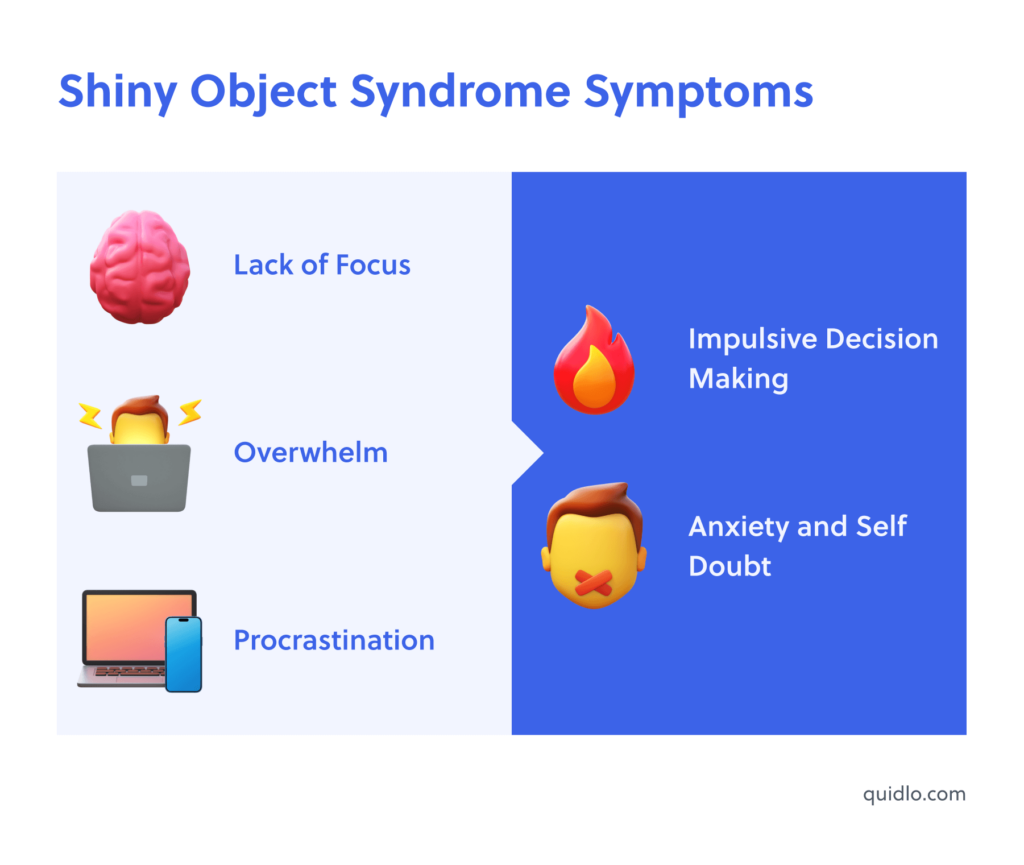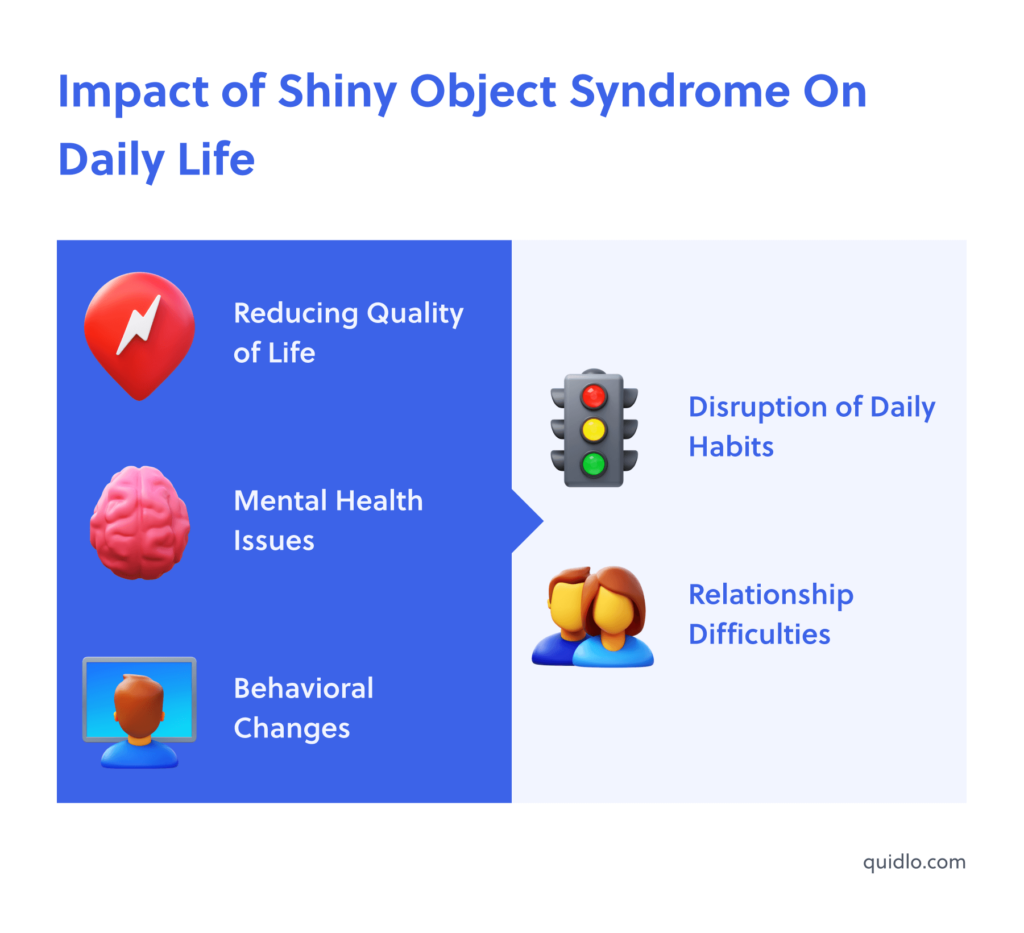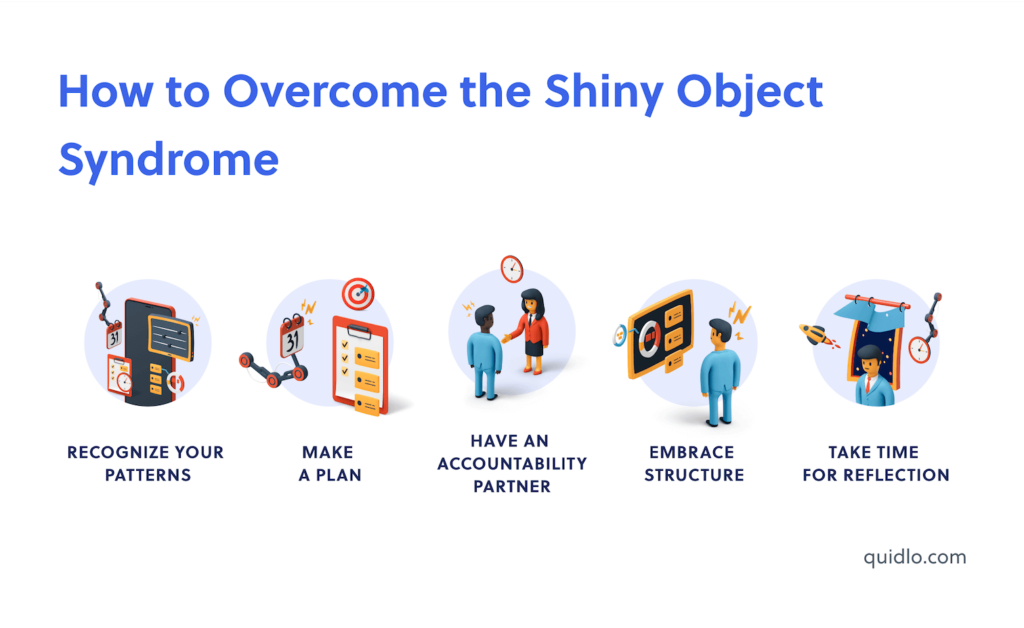It’s a new year, and you’re feeling excited. You have a new idea and ready to tackle all your goals. But then, boom! Suddenly, you’re bombarded with distractions. You see a post on social media that catches your eye. You drive by a flashy billboard. Someone in your mastermind group shares a new strategy they’re trying out, and you can’t help but be intrigued.
Before you know it, shiny object syndrome strikes, and you find yourself shifting your focus and priorities to chase after the latest and greatest shiny thing. Shiny Object Syndrome is an all-too-common occurrence in today’s world, and it’s a destructive temptation that can lead to disastrous consequences. In this blog post, we’ll explore what shiny object syndrome looks like and how having this tendency impacts life decisions, as well as the serious consequences it can lead to if not addressed properly.
Table of Contents
What is the Shiny Object Syndrome?
Shiny Object Syndrome (SOS) is a term used to describe the tendency of some people to become easily distracted by new, often seemingly trivial and unrelated, ideas or objects. It is a destructive habit that can lead to impulsive decision-making and a lack of productivity.
Shiny Object Syndrome has been around for a long time, and its lure can be seen in stories throughout history. It’s said that one of the earliest recorded accounts of SOS was when King Midas asked for his wish to be granted: he wanted everything he touched to turn to gold. But once the gods granted this wish, Midas quickly came to realize that it wasn’t all it was cracked up to be – now, everything he touched became a valuable but useless item.
Shiny Object Syndrome is an addiction that is hard to break because it has become so ingrained in our day-to-day lives. We live in a society that constantly encourages us to seek out the next new product or trend as a way of achieving satisfaction.
So it’s no wonder why Shiny Object Syndrome has become such a problem for people who struggle with staying focused and committed to their long-term goals. In a short period of time, what appeared to be a brilliant idea will seem mediocre. It’s an easy trap to fall into and can cause major problems with productivity, concentration, and goal achievement if left unchecked.
Unfortunately, this type of behavior often leads to lose focus, disappointment, lose interest and frustration. Instead of improving our lives over time, we are constantly seeking out short-term gratification, which comes from constantly chasing the next shiny object. Shiny Object Syndrome causes us to lose sight of our true values and dreams by consuming ourselves with the latest trends and fads that promise immediate results but don’t provide lasting value or fulfillment.
Shiny Object Syndrome Symptoms

Lack of Focus
Those suffering from SOS tend to jump from one task or project to another before completing any one thing. They often feel like they have trouble focusing on any single task for too long as they are quickly distracted by other ideas that come their way.
Overwhelm
With so many things competing for attention all at once, those who suffer from SOS often feel overwhelmed by the amount of work on new projects without ever actually starting anything. This creates an endless cycle where nothing gets done due to feeling overwhelmed by all the potential projects.
Procrastination
When faced with too many options, procrastination often sets in as a means of avoiding committing oneself to any one particular task or project until it’s absolutely necessary. This can lead to both short-term and long-term consequences, such as missed deadlines or lost opportunities due to lack of action taken when needed most.
Impulsive Decision Making
Due in part to feeling overwhelmed, those suffering from SOS often make decisions impulsively instead of taking time to plan out their next steps carefully before executing them; this can lead them down paths that weren’t intended originally, thus wasting valuable resources (time & money mostly).
Anxiety & Self Doubt
As a result of all these symptoms combined together, those suffering from SOS may experience anxiety and/or self-doubt about their ability (or lack thereof) to complete any given task successfully; this, in turn, further perpetuates the cycle above, leading back into procrastination…and so on.
Impact Of Shiny Object Syndrome On Daily Life

Reducing Quality of Life
Shiny Object Syndrome (SOS) can be damaging to someone’s quality of life. People who suffer from this affliction often have difficulty setting boundaries, so they are often easily distracted by anything that shines or sparkles like the proverbial shiny object. Those affected tend to focus on the short-term gain and don’t think about the long-term impact. This can cause a person to make impulsive decisions that may not be in their best interest, causing them to feel overwhelmed or undervalued.
Mental Health Issues
Shiny Object Syndrome also has serious implications for a person’s mental health and well-being. Because those affected by SOS tend to feel drawn towards items that ‘sparkle,’ they become easily trapped in a cycle of consumption which can lead to feelings of anxiety, depression, or even guilt.
Behavioral Changes
Those who suffer from Shiny Object Syndrome will also begin noticing changes in behavior when they are around certain objects or activities that trigger the syndrome. For example, they may become more agitated or impulsive while shopping; they may become more withdrawn when presented with certain items; and they may even start engaging in risky behaviors such as overspending without considering future consequences.
Disruption of Daily Habits
People with Shiny Object Syndrome can find it difficult to focus on tasks at hand as they are always drawn towards something else that catches their attention – whether this is an item-related purchase or just something else entirely irrelevant but visually pleasing – which disrupts daily habits and schedules thus leaving them feeling frazzled and scattered.
Relationship Difficulties
Shiny Object Syndrome can lead to feelings of frustration and confusion for those who are in relationships with someone who suffers from it, as they may find themselves unable to have meaningful conversations due to their partner’s tendency to be easily distracted and constantly switch the subject. This can ultimately lead to a lack of understanding in the relationship, creating an environment where it is difficult for either party to express themselves.
Examples of the Shiny Object Syndrome
The Shiny Object Syndrome is a splendor that occurs when people are drawn to new and enticing objects, ideas, or opportunities. Whether you are a regular employee or a business owner, it’s a natural human bent to be attracted to a new project that is shiny, exciting, and different. Let’s look into its example in a business context.
Shiny Object Syndrome in Business
- Failing to Stick to a Marketing Plan
Many businesses fall victim to Shiny Object Syndrome by constantly pivoting to the latest marketing trend or strategies. While it’s important to stay up-to-date on industry trends, constantly changing direction can lead to inconsistency in branding and messaging, confusing customers and diluting your marketing efforts.
- Changing Company Direction or Mission Statement to Follow Trends
Shiny Object Syndrome can impact a business by constantly changing the company’s direction or mission statement to follow the latest industry trend. This can lead to confusion among employees and stakeholders and can make it difficult for the business to establish itself as a leader in its field.
- Investing in New Technology or Tools Without Fully Evaluating Their Potential Impact
Shiny Object Syndrome can also manifest itself in the form of investing in new technology or tools without fully evaluating their potential impact on the business. While it’s important to stay up-to-date on the latest tools and technologies, it’s important to carefully consider how they will fit into your business goals and operations before making a decision.
- Focusing on Short-Term Gains Rather Than Long-Term Growth and Sustainability
Bright shiny object syndrome can also lead businesses to focus on short-term gains rather than long-term growth and sustainability. This can result in a lack of planning and strategy, leading to missed opportunities for growth and potentially jeopardizing the long-term success of the business.
The Impact of Shiny Object Syndrome on Business Performance
- Lack Of Consistency
Shiny Object Syndrome can lead to a lack of consistency in marketing and branding efforts, making it difficult for the business to establish itself as a trusted and reliable brand.
- Decreased Productivity and Morale
Constantly changing direction and priorities due to chasing shiny objects can lead to confusion and a lack of direction among employees and stakeholders. This can lead to decreased productivity and morale.
- Waste Of Resources
Investing in technologies or strategies that don’t align with the company’s goals due to Shiny Object Syndrome can result in wasted resources and decreased ROI.
- Difficulty To Measure Progress
The constant switching of tactics due to Shiny Object Syndrome can make it difficult to measure the effectiveness of marketing and business strategies, making it tough to identify what’s working and what isn’t.
- Decreased Customer Trust and Loyalty
Inconsistent branding and messaging due to Shiny Object Syndrome can lead to decreased customer trust and loyalty, as customers may feel uncertain about the business’s direction and priorities.
How to Overcome the Shiny Object Syndrome?
Have you felt like a moth to a flame, drawn to new and shiny things that promise quick success? If so, you’re not alone. In the business world, this behavior is known as the “Shiny Object Syndrome”. It affects even the most disciplined entrepreneurs and can have a negative impact on your productivity if you chase a new shiny object. Here are five tips to help you overcome Shiny Object Syndrome and stay focused on your goals.

Recognize Your Patterns
Step one in overcoming the Shiny Object Syndrome is recognizing when it happens. When do you find yourself getting distracted by all of the bright shiny objects? Are there specific times or situations when it’s more likely? Once you can identify your patterns, it’ll be easier for you to take control of them.
Make A Plan
Once you’ve identified what triggers your Shiny Object Syndrome, make a plan of action for how to deal with it in the future. This could include setting rules for yourself, like only looking at one new product each week or setting aside specific days or times to explore new products and new ideas instead of getting sidetracked during work hours. The goal should be to create a structure so that exploring new options doesn’t derail your progress toward completing existing successful projects and tasks.
Have an Accountability Partner
Having an accountability partner can help keep you on track when faced with the temptations of shiny objects. Choose someone supportive but also honest enough to call you out if they see you start slipping into old habits of distraction and procrastination. Make sure they understand your goals and why staying focused is important to you so they can help keep you accountable for reaching them!
Embrace Structure
Setting up systems and routines in place will help keep distractions at bay while still allowing room for exploration and creativity — two things essential for any business’s success! Structure helps ensure that we don’t get lost in the rabbit hole of possibilities by creating boundaries around our decisions making processes (e.g., only exploring one product per week). With structure comes clarity which allows us to focus on what matters most — our goals!
Take Time For Reflection
Reflecting on our progress allows us to gain insight into where we are going wrong or right with our strategies and helps us course-correct along the way if need be. Think about what you’re trying to achieve in the long run, and ask yourself if this new shiny object fits with those goals. Taking time for reflection also gives us space from all those shiny objects so we can make more informed decisions about which ones are worth pursuing without feeling pressured by time constraints or external influences (e..g., peer pressure).
Is It a Really Big Threat?
Shiny Object Syndrome, or the tendency to jump quickly from one project or idea to the next, can be a very big threat in business. The danger lies in the fact that it can cause rapid shifts in focus, resulting in lost productivity and wasted resources. This can be especially damaging for large companies with multiple departments and complex projects. It’s also hazardous for start-ups who may have limited funds and need to be extra careful about where they invest their money.
It’s not always easy to resist the temptation of a new shiny object, especially when it comes to business. However, as this blog has hopefully shown, succumbing to every new trend can be detrimental to your business in the long run. Be strategic about what you adopt and make sure it aligns with your company’s goals. Have you been guilty of Shiny Object Syndrome in your business? How did you overcome it? Share your story with us in the comments below.







